Polemonium reptans var. reptans, Greek valerian/Jacob's ladder, is a native perennial herbaceous plant that blooms in spring. This variety is native to NJ and is on the NJ "List of Endangered Plant Species and Plant Species of Concern" (May 2022) as S1 indicating that it is critically imperiled in NJ.
The common names are often shared with other look-alike species of Polemonium. Distinguishing features of look-alikes are presented.
Flowers
Inflorescence - terminal and axillary: The flowers of Polemonium reptans var. reptans form loose clusters at the ends of floppy stems. Some flower clusters form at the axils of the upper leaves. The clusters contain 5-17 flowers on pedicels (flower stalks) that are about 5mm. long. The flowers are upright to nodding.
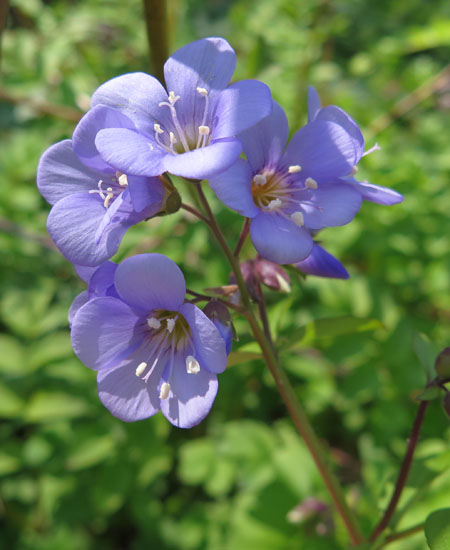
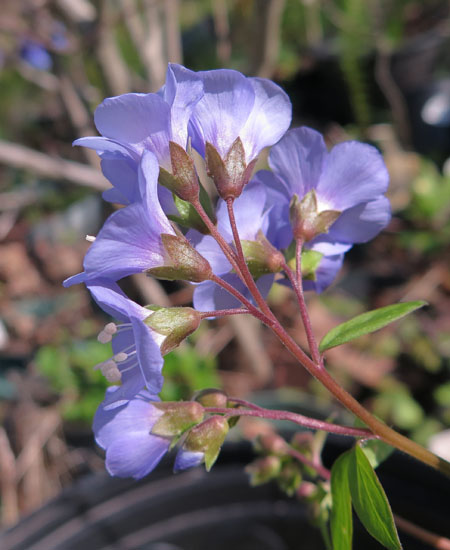
Flowers: P. reptans has powder blue to lavender corollas (petals) and are bell-shaped opening into 5 lobes. The corollas are about 3/4 inches long or about 2/3 inch across. The corollas are hairless.
There are 5 stamens, with 3 slightly different than the other two. The white anthers extend to the edge of the petals or less.
The ovary is green and spherical. The slender white style and 3 parted stigma extend slightly beyond the petals.
There are nectaries at the base of the ovaries.
The flower calyces/sepals are bell shaped forming around the midpoint 5 pointed lobes. They are light green to reddish purple and glabrous or sparsely and minutely hairy.
The flower promotes cross-pollination by having the anthers mature before the stigma (protandry). The stigma extends beyond the anthers also decreasing the likelihood of self-pollination. Furthermore, there are reports that the plants are self-incompatible so they are described as obligate outbreeders relying on pollination which is mostly done by bees. The plant has nectar and pollen to offer its pollinators.
It blooms around the end of April and lasts about 2-3 weeks.
Young flower, pistil not mature, one of the stamens still uncurling, one inner stamen starting to mature.

The lower right anther is beginning to open exposing the pollen inside.

Close-up: The triparted stigma is closed (red arrow) and the 5 anthers are mature (protandry).
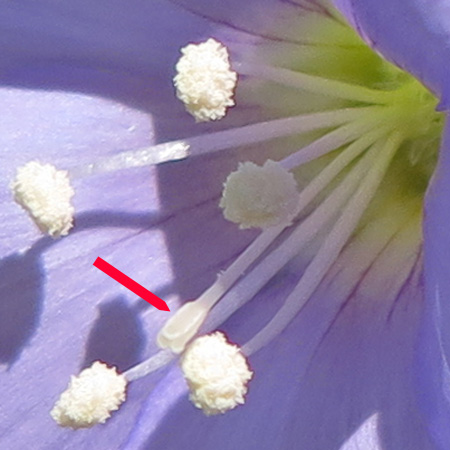
Close-up: The triparted stigma and the 5 anthers are mature. The pollen is white. At the inner base of the corolla there are purple lines act as nectar guides.

Anthers are dehiscing. The pollen grains are circular

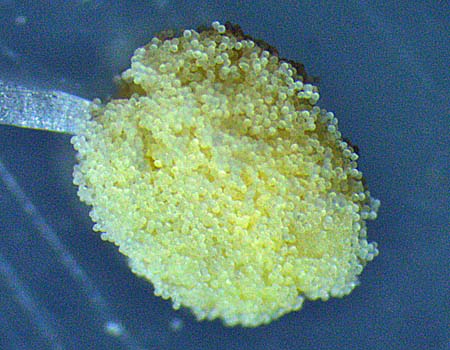
This flower produces copious amounts of nectar. Surrounding the base of the ovary is a nectary ring. Photo: view into throat of a dissected flower: red arrow - defocused expanded ovary; blue arrow - nectary ring with two drops of nectar on it. The nectar is released through pores in the nectary.
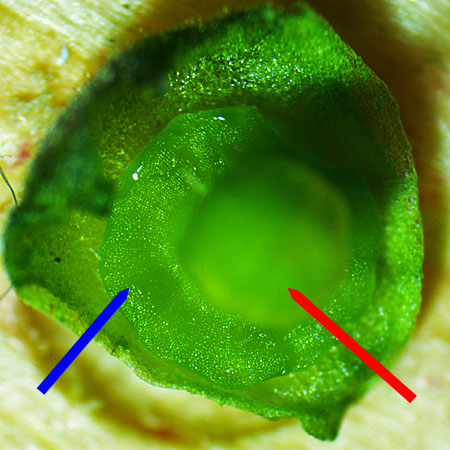
Buds showing the twisted petals.
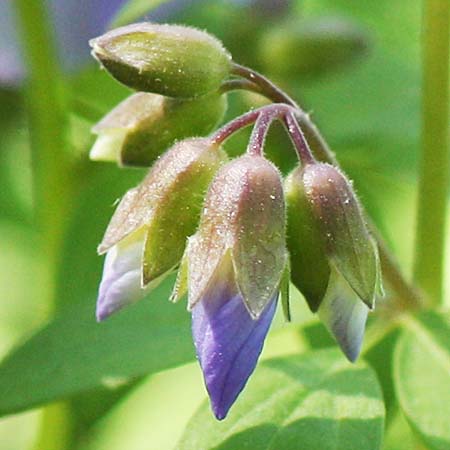
The purple streaks are more pronounced here. Two of the anthers are in different stages. The stigma is mature.

Fruit
The fruits of P. reptans are formed in the 5 lobed calyces that are about quarter inch at flowering. The calyces expand to about half inch and become inflated and papery at fruiting. The lobes are triangular and come to a point and enclose the maturing ovary.
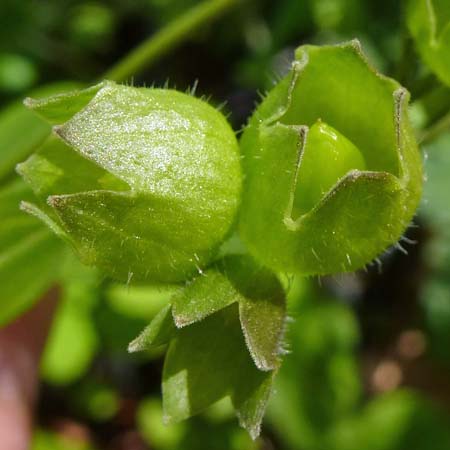
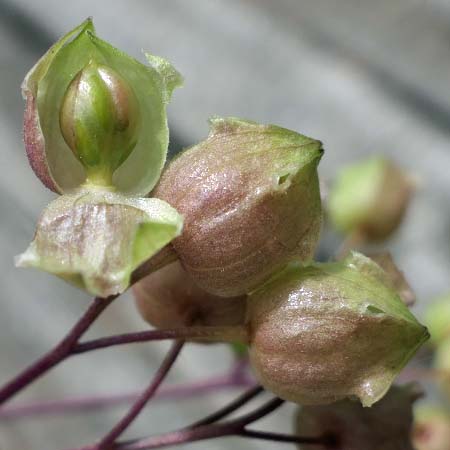
Arrows point to the short stalks on the fruits. The short stalks are a species distinguishing feature.

Leaves
P. reptans leaves are alternate and compound odd-pinnate. The entire leaf is up to 8 inches long. The leaflets are sessile, opposite (occasionally alternate) with smooth margins and about 1 inch long. A leaflet is about twice as long as it is wide. There are 3 conspicuous veins on the surface. There are usually 5 to 17 leaflets. Near the top of the stem the leaves have only 3-5 leaflets.
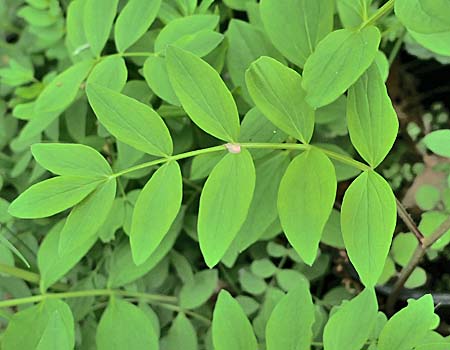

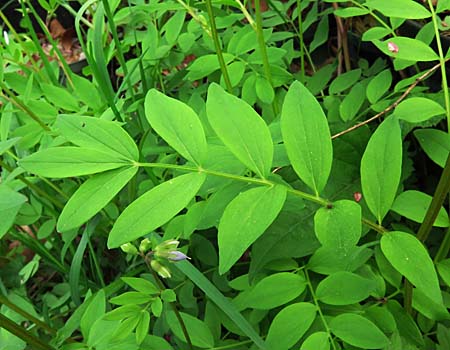
Plant and Habitat
Plant & Habitat:
P. reptans forms in small clumps with multiple leafy flower stems that are upright to reclining and 8 to 20 inches tall. The stems sometimes branch near the top.
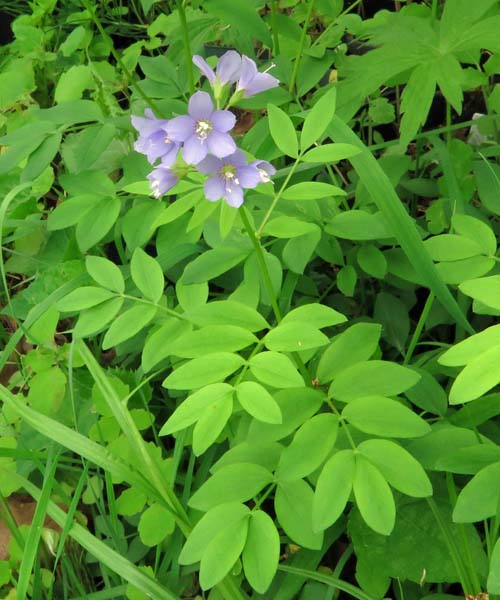
Habitat: P. reptans can grow in a variety of habitats making it a good candidate for gardening. It grows best in places were it can receive some direct sunlight and is partially shaded part of the day.
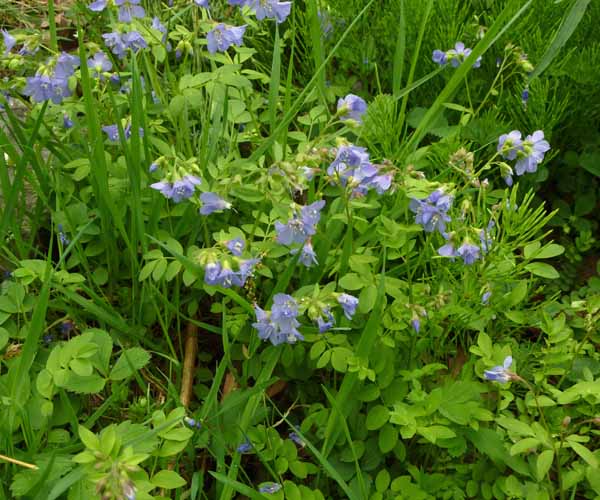
Look-alikes
First of all, there are two variations of Polemonium reptans: P. reptans var. reptans and P. reptans var. villosum.
-
P. reptans var. reptans is native to NJ and many eastern states.
It is S1 (Critically Imperiled) in NJ and T5 (Variety Secure globally).
mainly non-glandular hairs and not profusely. -
P. reptans var. villosum is native only to Ohio & Kentucky.
profuse glandular hairs on the stems, flower stems (pedicel) and sepals and on some of the young leaf stalks.
Secondly, there are several species Polemonium that look like P. reptans.
- - - P. reptans vs. P. vanbruntiae - - -
P. reptans:
- leaflets sessile
- stamens and style not or shortly exserted from corolla
- white, cream-white anthers
- 11 – 17 leaflets
- weak and reclining
P. vanbruntiae: NJ SX(Possibly Extirpated)
- leaflets not sessile, leaflet stalks mostly 0.1–1.5 mm long
- stamens and style are well exserted from corolla,
- yellow anthers
- 15 – 21 leaflets
- more erect in habit
- - - P. reptans vs. P. caeruleum - - -
P. reptans:
- stamens and style not or shortly exserted from corolla
- white, cream-white anthers
- larger leaves with 11–17 leaflets, leaflets wider, leaflets are sessile
- fruit short-stalked
- corolla 12–16 mm long
P. caeruleum: From Europe and present in NJ
- stamens and style are well exserted from corolla
- yellow anthers
- larger leaves with 19–29 leaflets, leaflets narrower, leaflets are sessile
- fruit sessile
- corolla 15–20 mm long
Although both P. reptans and . P. vanbruntiae are rare in NJ, however, they are commercially available for your gardens.
- Cultivars: We prefer non cultivars for our garden
- P. reptans: 'Stairway to Heaven' It is readily available
- P. boreale 'Heavenly Habit': P. boreale is native to areas in the arctic. However, its cultivar, 'Heavenly Habit' is readily available.
Text by Millie Ling and all photos by Hubert & Millie Ling. Dissections & microscopy by Hubert Ling. Photos: all from cultivation, Central Jersey.
Additional information
Additional information / references:
- The USDA website shows Polemonium reptans var reptans- Greek Valerian/Jacob's ladder distribution in the US and other information: https://plants.usda.gov/home/plantProfile?symbol=SYFO
- Gardener's News article on greek valerian Click Here
- Illinois Wildflowers https://www.illinoiswildflowers.info/woodland/plants/jacob_ladder.htm
- Geogia biodiversity rare plants: https://www.georgiabiodiversity.com/portal/profile?group=plants&es_id=17949
- Comprehensive report:
Dodds, Jill S. 2023. Polemonium reptans var. reptans Rare Plant Profile. New Jersey Department of Environmental Protection, State Parks, Forests & Historic Sites, State Forest Fire Service & Forestry, Office of Natural Lands Management, New Jersey Natural Heritage Program, Trenton, NJ. 18 pp. https://www.nj.gov/dep/parksandforests/natural/heritage/docs/polemonium-reptans-var-reptans-greek-valerian.pdf - GoBotany: key to some look-alikes https://gobotany.nativeplanttrust.org/dkey/polemonium/#all
- Jersey Friendly Yards: cultivation https://www.jerseyyards.org/plant/polemonium-reptans//